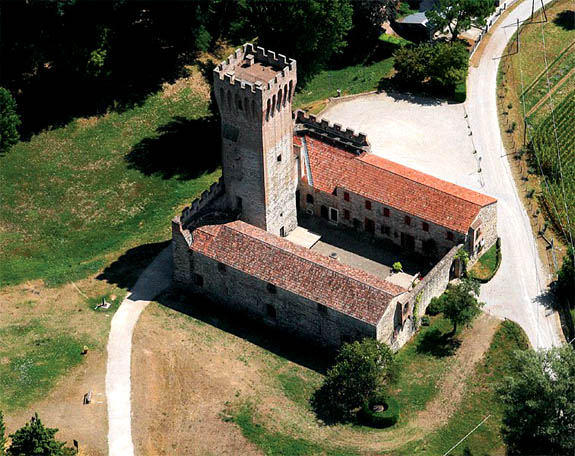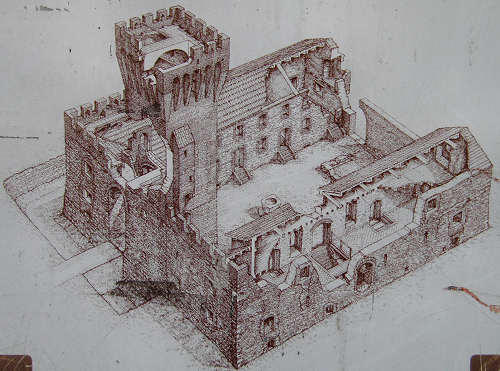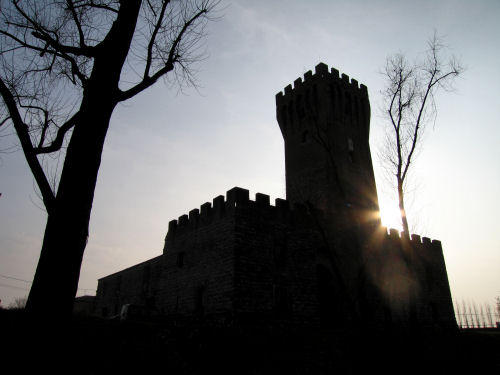|

The tower, approximately seven metres high, emerges picturesquely from a forty-year old poplar grove and seems the classic representation of a castle. It is so evocative that the tradition holds that it was the same castle painted on the background of the Tempesta by Giorgione, chosen by the artist as a memento of his stay in San Martino.
The story of the small fort contributes to making it symbolic for many Italian castles: the change in its destination of use first for historical reasons - following technological developments of weapons - and then to the aim of preserving and allowing citizens use an item of public property.
 Before the year 1000, the defensive system erected near the Bacchiglione River was just a tower. At the beginning of the 1300s, because of the victorious advance of the troops of the della Scala family, the defence line north of the Tower of San Martino was reinforced. For his strenuous defence of the city-state against Cangrande, Nicolò da Carrara was compensated with the bequest of the tower by Padua in 1324. Before the year 1000, the defensive system erected near the Bacchiglione River was just a tower. At the beginning of the 1300s, because of the victorious advance of the troops of the della Scala family, the defence line north of the Tower of San Martino was reinforced. For his strenuous defence of the city-state against Cangrande, Nicolò da Carrara was compensated with the bequest of the tower by Padua in 1324.
The most important configuration came with the da Carrara family. On the southern side, an enclosure in trachyte stone was built (or perhaps just renovated), that was 10 metres high and topped by battlements. On three sides, as many factories with lodging were inserted. Then the tower was banked up and made more elegant by a refined crown of battlements in brick, jutting out at intervals, and posted on high overhanging spurs, a solution similar to that adopted for Porta Padova at Montagnana.
As the residence of the Commander of the castle and of the entire military camp, the tower was organized like a real lodging, distributed over six floors. The complex still bears the traces of the construction techniques for the defence system, like the high, narrow arrow-slits on the ground floor of the enclosure, or the watchtower on the southern side. The Castle was always invincible, and as sources tell, it fell only because of a betrayal, thus becoming property of Venice.
With the establishment of the Venetian rule this defensive structure los t its significance and fell into disuse. In 1489 it was rented to the Vendramin, a noble Venetian family who traded in cereals. Years later, they built the cottage found at about 200 metres east. Under the aegis of the Venetian peace, the castle was linked to the destiny of the Bacchiglione River, and this area saw its trading activity grow. The wood of the Carpaneta, in fact, supplied firewood and a large quantity of excellent oak for the Venice Dockyard. Carbonara produced coal, while the lime caves and the brick works of Vegrolongo developed rapidly. Since this merchandise was transported to Venice via water, the interior of the castle had become a fluvial market and an important centre of commercial sorting by the 17th century. The new situation produced the following destination of use of the castle as a boarding place and a wine tavern. The complex of buildings remained property of the Vendramin family until the middle of the 1800s. t its significance and fell into disuse. In 1489 it was rented to the Vendramin, a noble Venetian family who traded in cereals. Years later, they built the cottage found at about 200 metres east. Under the aegis of the Venetian peace, the castle was linked to the destiny of the Bacchiglione River, and this area saw its trading activity grow. The wood of the Carpaneta, in fact, supplied firewood and a large quantity of excellent oak for the Venice Dockyard. Carbonara produced coal, while the lime caves and the brick works of Vegrolongo developed rapidly. Since this merchandise was transported to Venice via water, the interior of the castle had become a fluvial market and an important centre of commercial sorting by the 17th century. The new situation produced the following destination of use of the castle as a boarding place and a wine tavern. The complex of buildings remained property of the Vendramin family until the middle of the 1800s.
After several changes in ownership, in 1978 its latest owners, Antonini Papafava dei Carraresi, donated it to the Consortium for the Development of the Euganean Hills, hence to the County Government of Padua.
Nowadays, and after considerable restoration processes, the entire structure is the headquarters of the Museum of the Bacchiglione River and its territory.
|